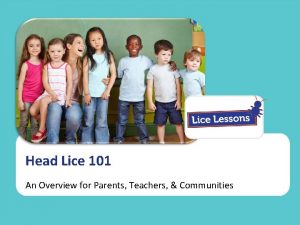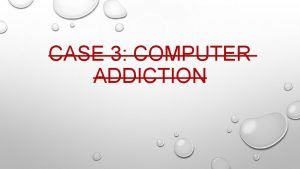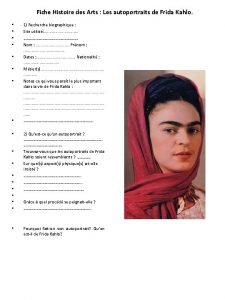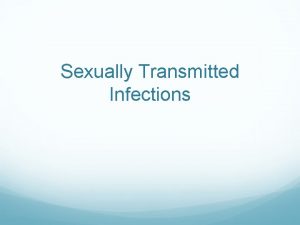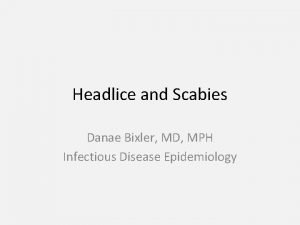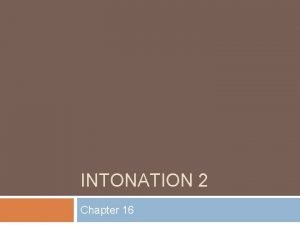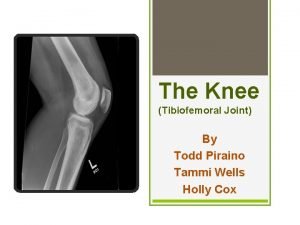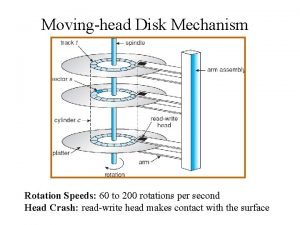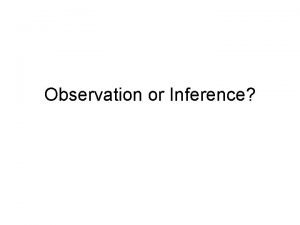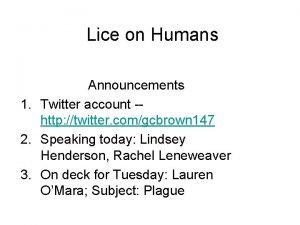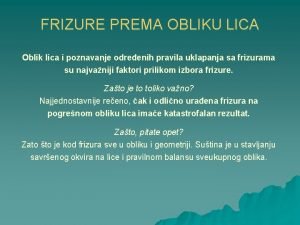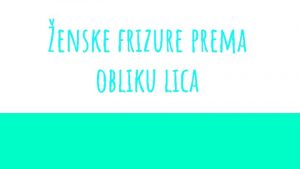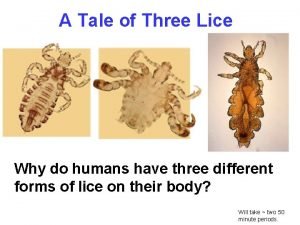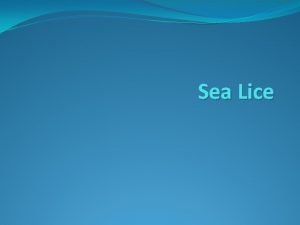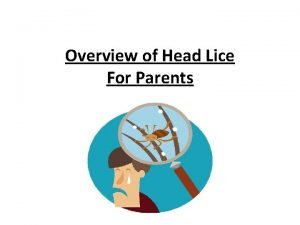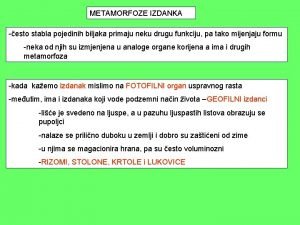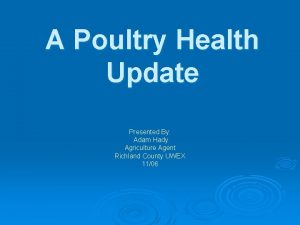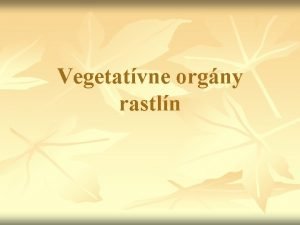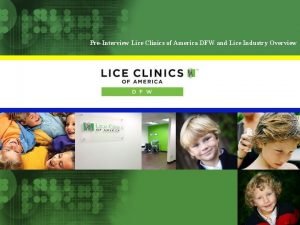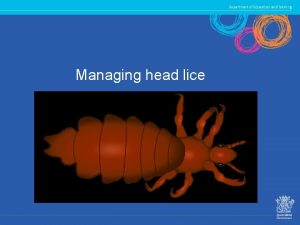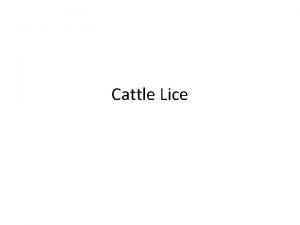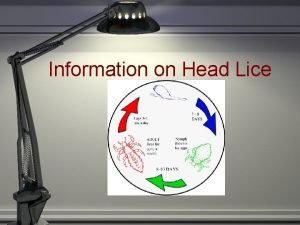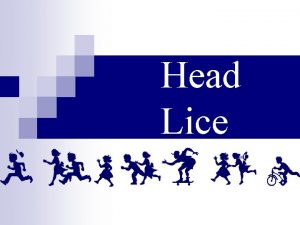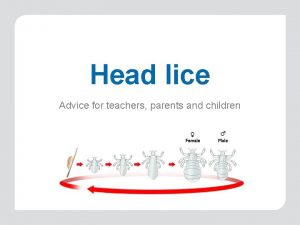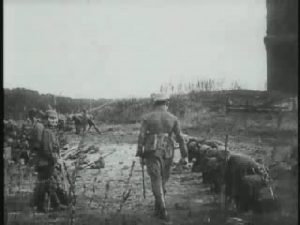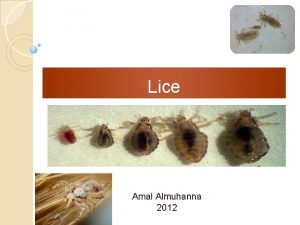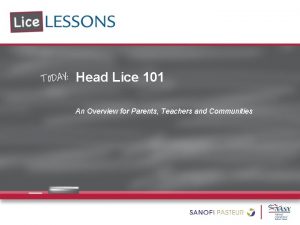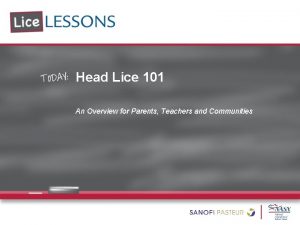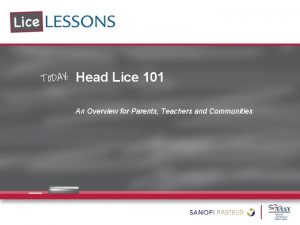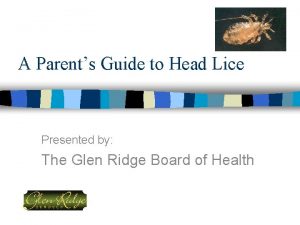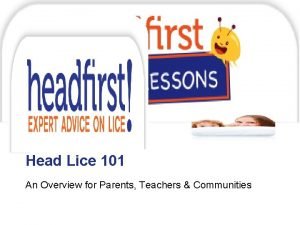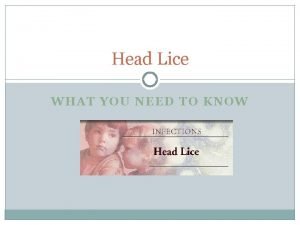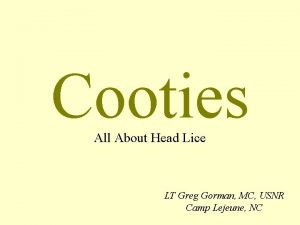HEAD LICE Advice for Schools and Parents What








































- Slides: 40

HEAD LICE Advice for Schools and Parents

What are head lice ?

Head Lice – The Facts • Head lice are tiny greyish brown wingless insects • An adult louse is about 2 mm long – the size of a sesame seed.

Head Lice – The Facts Head lice are not nits

Head Lice – The Facts • Nits are actually the empty egg cases of head lice • Nits can remain weeks or even months after an infection • Nits do not necessarily mean you have head lice – look for living, moving louse using the recommended detection method

How do we get head lice ?

How do we get head lice? • • Head lice live in the hair, right next to the scalp They live in any hair – clean or dirty, long or short They cannot hop, fly or jump Head lice are spread through direct head to head contact

How do we get head lice? • Head lice can infect anyone – not just children • Many infections are spread by families and friends • You are unlikely to catch head lice from objects such as chair backs, hats or towels • Lice do not cause or carry disease • Knowledge can help control their spread

How do I know if I have head lice?

How do I know if I have head lice? • Some people will get an itchy scalp But – • You may not know you have head lice • Detection combing is the best method of identifying head lice

What is detection combing?

What is detection combing? • Step 1: Buy a special detection comb from your local pharmacy • Step 2: Make sure you have plenty of light – ideally natural daylight

What is detection combing? • Step 3: Wash hair well with an ordinary shampoo and towel dry until damp, not dripping • Step 4: Remove tangles with an ordinary comb

What is detection combing? • Step 5: With the teeth of the detection comb touching the scalp at the top of the head, start combing towards the end of the hair, keeping the teeth of the comb in contact with the scalp as long as possible. Keep a close eye on the comb for any signs of head lice

What is detection combing? • Step 6: Repeat the process moving round the whole of the head. It will take 10 -15 minutes to do properly

What is detection combing? • Step 7: Keep checking the comb. Wiping it on a tissue can help identify the head lice. If a living moving louse is found, you have head lice. However you must not be treated unless you find a living, moving louse

What is detection combing? • Step 8: It is best to perform detection combing on anyone who is likely to have had head to head contact with the affected person

How do I treat the infection?

How do I treat the infection? • Treatments containing an insecticide are the only method clinically proven to be effective • Nix Crème Rinse or R+C are clinically proven, 10 minute treatment suitable for asthmatics • Nix Crème Rinse or R+C are tough on head lice, but kind on kids

How do I treat the infection? • The application is quick and easy to use, and is just like applying conditioner • Experts recommend a second application after 7 days to ensure that any lice that may be emerging from eggs that survive the first application are eradicated • Nix Crème Rinse and R+C contain Permethrin, based on pyrethins – derived from chrysanthemum flowers (*Always ask your pharmacist for advice and always read the label)

How do I treat the infection? Other options include: • Repeated wet combing over several weeks • “Electric combs” • Essential oil preparations None of these are supported by clinical evidence to prove their effectiveness in treating infections

How do I treat the infection? • • Remove all nits by pulling them off with your fingers This can take time but is the most important step a nit comb can help Checking for and removing nits should be done daily for 14 days Head Lice Control Checklist, IERHA, July 2013

Household cleaning • There is no evidence that a major household clean-up will help get rid of head lice • Head lice do not survive well away from their food source and survive only in a certain temperature & humidity range • Eggs do not hatch off the head • Lice rarely move from the scalp so it is not likely they will spread through casual contact with furniture or carpeting • Articles that are most likely to transmit lice are those that come in contact with the head and neck (hats, helmets, furry coat collars, scarves, hair brushes, combs and hair ornaments) Head Lice Fact Sheet, Manitoba Health, February 2012

Household cleaning • Soak combs, brushes, hair clips in very hot water for 15 minutes • Wash personal belongings (especially head gear), recently worn clothing, towels and bed linen in hot water. Dry using hot cycle of the dryer • Items that cannot be exposed to hot water should be either placed in a hot dryer for 20 minutes, frozen at -20 C for 24 hours, sealed in a plastic bag for 10 days or dry cleaned • Vacuum or wash area where there had been direct head contact (couch, bed, car seat) Head Lice Control Checklist, IERHA, July 2013

How do we prevent it?

How do we prevent it? • Anyone with head lice will have been infected by someone around them • Contact tracing helps prevent the spread of an infection

How do we prevent it? • Step 1: If you find a living, moving louse, tell anyone you have been in contact with • Step 2: Advise them to use the detection method and if they find live lice, to tell everyone they have been in contact with

What do schools have to do with it?

What do schools have to do with it? • Head louse infections are a community problem – not just a school problem But – • Schools are at the “frontline” as so many children are in contact with each other

What do schools have to do with it? • Infections can spread in the classroom as there may be prolonged head to head contact when children huddle together over their desks • Break-time, lunch time and out of school play also help the infection to spread, as children come into close contact with each other

What do schools have to do with it? • There is a low level of head louse infections usually present in the community • At any time, 2 -5% of children in a school will have head lice • An “outbreak” is unlikely to be so widespread as parents may imagine • A child should not miss more than one day of school because of treatment for head lice • Children do not have to be “nit-free” in order to return to school or day care • Exclusion is not recommended. It is not necessary to isolate the child if the child is remaining at school

What can schools do?

What can schools do? • Provide support, advice and information as part of an ongoing health initiative • The public health nurse can advise on the causes and treatment of head louse infection, provide support and supplies, if needed, to families

What do we need to remember?

What do we need to remember? • • Infections are not a health threat Detection and treatment are simple Schools should keep an infected child’s identity confidential The school can provide ongoing support and information

Visit www. gov. mb. ca/health/publichealth/cdc/protocol/headlice. pdf www. gov. mb. ca/health/publichealth/factsheets/headlice_checklist. pdf www. caringforkids. cps. ca/handouts/head_lice www. kidshealth. org

• Reliable online source of information on head lice • Provides advice and materials to manage head lice

On the websites you will find…

• • facts on head lice Information for parents – factual and reassuring Check list for treatment and cleaning associated with head lice Treatment advice for parents

THE END
 Head lice poster for parents
Head lice poster for parents From the research do boys and girls share the same internet
From the research do boys and girls share the same internet Reach target safety
Reach target safety Frida kahlo grand parents
Frida kahlo grand parents Parents parents
Parents parents Fiche frida kahlo
Fiche frida kahlo Huntsville city schools returning student registration
Huntsville city schools returning student registration Difference between dividing head and indexing head
Difference between dividing head and indexing head Pro minent
Pro minent Gonorrhea
Gonorrhea Pictures of body lice and scabies
Pictures of body lice and scabies The attacking firm goes head-to-head with its competitor.
The attacking firm goes head-to-head with its competitor. Moving head disk mechanism
Moving head disk mechanism Neck part of body
Neck part of body What is a tonic syllable
What is a tonic syllable Biceps femoris short head
Biceps femoris short head What is tone unit
What is tone unit Moving head disk mechanism
Moving head disk mechanism Prinosimo kruh jedemo tijelo kristovo tekst
Prinosimo kruh jedemo tijelo kristovo tekst Lice in the trenches
Lice in the trenches Sewer lice
Sewer lice Twitter
Twitter Ja dolazim pred tvoje lice
Ja dolazim pred tvoje lice What does a baby lice look like
What does a baby lice look like Ovalno lice frizure
Ovalno lice frizure Lisni rukavac
Lisni rukavac Frizure za dijamantni oblik lica
Frizure za dijamantni oblik lica Body lice pictures
Body lice pictures Sea lice new jersey
Sea lice new jersey Pravilnik za mikro pravna lica
Pravilnik za mikro pravna lica Lice
Lice Lice i naličje lista
Lice i naličje lista Bijahu glagolski oblik
Bijahu glagolski oblik Lice
Lice Lice
Lice Vodno lice
Vodno lice Bifaciálny list
Bifaciálny list Lice removal dfw
Lice removal dfw Vrsta pravne osobe
Vrsta pravne osobe Fspos vägledning för kontinuitetshantering
Fspos vägledning för kontinuitetshantering
